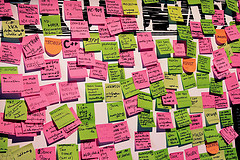Welcome to this week’s Language Blog Roundup, in which we bring you the highlights from our favorite language blogs and the latest in word news and culture.
In politics and language, Jen Doll at The Atlantic discussed linguistic crutches such as VP Joe Biden’s literally, while The New York Times explored President Obama’s English and other presidential speaking styles (or lack thereof).
Fritinancy’s words of the week were politically inspired: feckless, from John McCain’s statement regarding Obama’s “feckless foreign policy,” and arithmetic, from Bill Clinton’s speech at the Democratic National Convention (“What new ideas did we bring to Washington? I always give a one-word answer: Arithmetic.”).
Lucy Ferriss and Ben Zimmer both examined Mr. Clinton’s folksy rhetoric, while Ms. Ferriss also took a look at pharaoh’s chickens and Mitt Romney, and Mr. Zimmer wondered why everyone from Bill Clinton to Mark Zuckerberg was doubling down.
At Language Log, Ben Zimmer discussed ambiguity in politics and advertising; Victor Mair examined censorship in China; and Mark Liberman delved into mommy and daddy parties and euphemisms and The New York Times. At Lingua Franca, William Germano interpreted signage in the UK; Ben Yagoda explained the nonsensical nature of idioms; and Allan Metcalf analyzed the nasal drawl.
At Macmillan Dictionary blog, Orin Hargraves decoded tech talk while Paul Cook hunted for lexical blends the computational way. Stan Carey put on a sock puppet show, and on his own blog, explored meanings and origins of feck and shared some animated etymology. Johnson told us about the best word ever and place names as shibboleths.
In words of the week, Erin McKean noted the fashionable smasual, smart-casual; Manhattanhenge, “the twice-a-year phenomenon where the setting sun aligns with Manhattan’s roughly east-west street grid”; swellegance, a blend of swell and elegant; and noodnik, “a Yiddish word that comes from a root meaning ‘to bore, to pester.’” Arnold Zwicky posted about micropolitans, “cities [that] do not have the economic or political importance of large cities, but are nevertheless significant centers of population and production.”
Word Spy spotted fiberhood, “a neighborhood that has Internet access via fiber-optic cable”; foodbaby, “a distended stomach caused by overeating”; and mansplaining, “explaining in a patronizing way, particularly when done by a man who combines arrogance with ignorance of the topic.”
Dialect Blog talked about this and that in foreign dialects and the South African ee. The Virtual Linguist looked at canny and uncanny, gender bias in job ads, and predistribution, “an alternative to the policy of ‘redistribution’ … meant to tackle the problem of inequality earlier in the process.”
Grammarphobia gave us a short history of the word wow. Sesquiotica explained around, about, and approximately; the origins of pissant and git; and peplum, “that skirt-like bit that some tops have attached to them at the waist.” Meanwhile, Lauren Conrad listed the ten most mispronounced words in fashion.
In the land of Shakespeare, we got excited about Joss Whedon’s Much Ado About Nothing and fell in love with these beautiful cut-paper illustrations of Romeo and Juliet. We were taken with these Scandinavian fairy tale illustrations and these science fiction visual interpretations. We squeed over the graphic novel version of A Wrinkle in Time.
We were intrigued by the idea of a Chinese translation of James Joyce’s Finnegan’s Wake and were wowed by these bookstores repurposed from unused structures. We learned about the “hipsterfication” of Australian pubs, organic syntax, some diner lingo, and how to drink like Hemingway. We found out where letters come from. We chuckled over Charles Dickens’s library of fake books (Bowowdom sounds like a bestseller) and laughed out loud at this Fred Armisen-as-Penny Marshall book trailer.
That’s it for this week!
